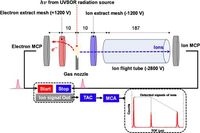A new study reveals the ionization dynamics of the low global warming potential etching gas C3HF5, demonstrating its potential for improved performance in advanced semiconductor manufacturing processes.
This investigation into C3HF5 (CF3CHCF2, KSG14), a promising substitute for traditional perfluorocarbon etching gases used in integrated circuit manufacturing, comes at a pivotal time as the semiconductor industry grapples with environmental challenges. Perfluorocarbons (PFCs) have long been notorious for their high global warming potentials, prompting scientists and engineers to seek alternatives with lower environmental footprints. According to the recent research published on March 19, 2025, C3HF5 not only boasts a global warming potential of less than 1, but it also shows robust performance characteristics essential for etching applications.
Conducted at the UVSOR facility in Japan, the study employs photoelectron–photoion coincidence (PEPICO) spectroscopy to delve deep into the dissociative photoionization dynamics of C3HF5 over a wide energy range of 10.0–26.0 electron volts (eV). Key insights reveal that during these processes, C3HF5 primarily fragments into a range of ions: C3HF5+, C3F5+, C3HF4+, C3F4+, C2F3+, and CF3+, with appearance energies determined that shed light on the fragmentation pathways at low electronic transitions.
The study specifically highlights how the parent ion, C3HF5+, appears at the lowest energy of around 10.6 eV, marking its stability in low-energy environments. Slightly higher energies saw the ion C3F5+ emerge at 10.7 eV as part of a reaction pathway involving hydrogen loss, showcasing the gas's nuanced breakdown dynamics. A deeper understanding of these fragmentation patterns not only enhances knowledge regarding etching gas behavior but also underscores C3HF5’s suitability for high-aspect-ratio structures, a significant need for advanced 3D flash memory technologies.
Analysis of the ion yield reveals that at photon energies below 14 eV, the C3HF5+ ion dominated, constituting approximately 80% of the detected ions. However, as photon energy escalated beyond 14 eV, the fragmentation dynamics shifted, with ion species such as C2F3+, C3HF4+, and C3F4+ taking precedence. This transformation elucidates the adaptability of the etching process, suggesting that careful control of ion bombardment energy, composition, and photon energy can drive successful etching outcomes for high-aspect-ratio SiO2/SiN stacked layers.
"C3HF5 prominently fragments into various ions, highlighting its potential as an environmentally friendly etching gas with excellent performance characteristics," wrote the authors of the article. Moreover, the findings present opportunities for optimizing the etching processes within semiconductor manufacturing, with a particular focus on the generation of reactive species needed for effective plasma etching.
The researchers employed a meticulous methodology by leveraging photon energy resolutions of 4.2 meV, obtained through optimized configurations involving a grating with a high number of lines per millimeter, ensuring the results achieved a high level of precision. This allows for a comprehensive understanding of how C3HF5 can influence etching processes and build a foundation for future innovations in gas design strategies.
Further analyses revealed that the lowest ion yield around 14 eV indicated the dominance of fragment ions C3HF4+ and C3F4+, signifying a shift towards more reactive species and potential pathways for improved etching efficacy. CF3+ ions particularly stood out during higher photon energy ranges (19 to 26 eV), indicating their significance in creating the chemical interactions necessary for effective etching processes.
As noted by the authors, "The findings of this study provide valuable insights into the dissociation pathways of C3HF5 and their potential roles in the etching of SiN and SiO2 films." This pivotal research serves as a beacon for the semiconductor industry, striving towards sustainability while meeting the relentless demand for innovation in chip manufacturing.
Ultimately, understanding the intricacies of C3HF5's fragmentation processes could pave the way for further advancements in semiconductor technology, combining environmental stewardship with the cutting-edge capabilities demanded in the manufacturing of advanced memory devices. Control over the generation of specific ions during the etching process could lead to optimized selectivity control, directly impacting the efficiency and efficacy of high-aspect-ratio etching performance.




